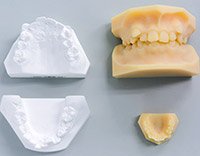 ASO International, a leading Japanese orthodontic laboratory, has enjoyed steady growth since its founding in 1982. Beginning as a one-man dental laboratory in downtown Tokyo, the company now has 46 business bases serving nearly 70 percent of the Japanese orthodontic market. But approximately 10 percent of the company's business comes from serving orthodontists in overseas markets, a number that Toshimasa Aso, CEO of ASO International, plans to increase with the help of 3D printing technology from Stratasys.
ASO International, a leading Japanese orthodontic laboratory, has enjoyed steady growth since its founding in 1982. Beginning as a one-man dental laboratory in downtown Tokyo, the company now has 46 business bases serving nearly 70 percent of the Japanese orthodontic market. But approximately 10 percent of the company's business comes from serving orthodontists in overseas markets, a number that Toshimasa Aso, CEO of ASO International, plans to increase with the help of 3D printing technology from Stratasys.
Aso first learned about this new method of orthodontic engineering in 2001 at the American Association of Orthodontists conference in Chicago. At the show, he was introduced to an Objet Eden260V 3D Printer that was particularly well adapted for orthodontic work. Upon returning to Japan, Aso further explored the potential of 3D printing and shortly thereafter purchased an Objet Eden 3D Printer for the Japanese office. Little did he know then that it would play a major role in helping the company broaden its presence worldwide.
Today, the use of digital technology has allowed the company to operate in ways it was never able to before. Toru Kawakami, general manager for the company's CAD/CAM division explains, "We can receive STL data from anywhere in the world and then create models using our Eden260V 3D Printer. Now we can work with an orthodontist located just a few miles away or one that is located 5,000 miles away. Our ability to serve more customers has grown exponentially."
The technology has also allowed the company to increase efficiency by streamlining its production process, as well as increase the number of orthodontic solutions it can offer customers, such as lingual jig trays. 3D printing also allows the company to do most of its development work in-house, thereby minimizing the need to outsource, while maintaining its high quality standards.
Finally, physical models can be stored as digital files which eliminate large amounts of storage space as well as the associated costs. This approach has resulted in other cost savings as well says Kawakami.
"We have centralized the collection of all models from orthodontists at our Tokyo headquarters. Sending scanned 3D data instead of physical models to customers produces significant savings on transport costs, while eliminating the risk of damage to the models in transit."
New Technology Equals New Opportunities
But the use of 3D printing technology has even greater implications for the continued success of the company and its global ambitions.
"The use of cutting edge technology allows us to capitalize on new and emerging opportunities. Orthodontists always approach us with new ideas, asking us to do new things. Without new technologies like 3D printing, we wouldn't be able to meet their expectations and grow our business," comments Aso.
"We are ready to target the top end of the global market. The Objet Eden260V from Stratasys will be key in helping the company to achieve this goal."





























































































